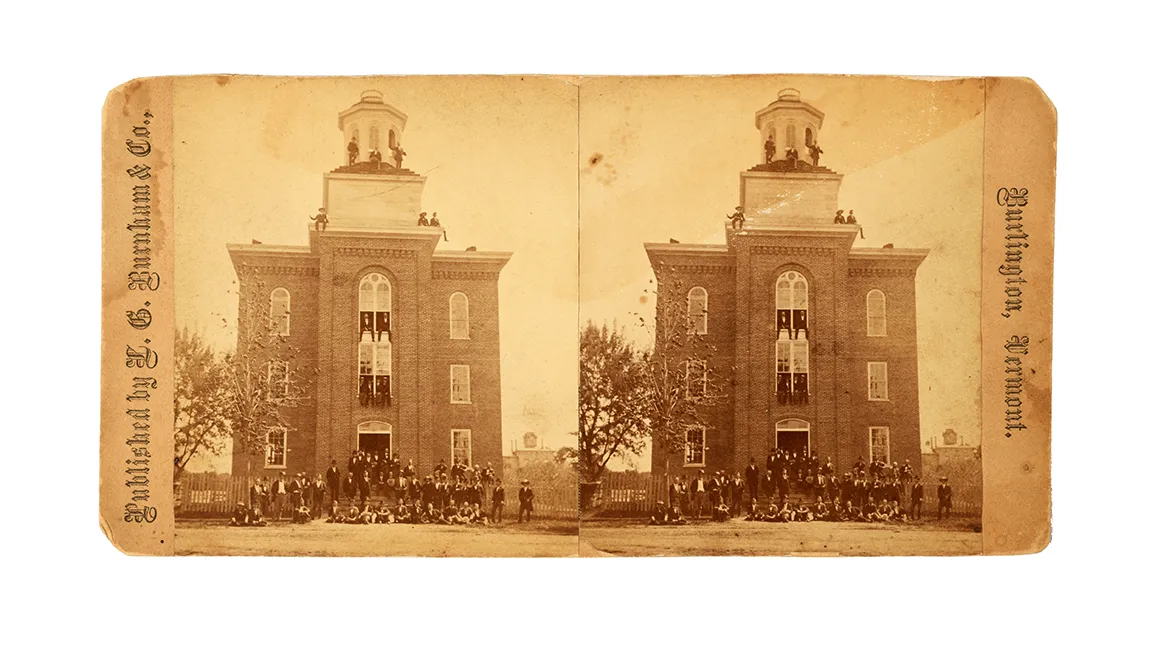It all comes down to one crucial figure: the patient. A medical school has hundreds of faculty, staff members, and students, thousands of square feet of laboratory and teaching space, and millions of dollars in research funding; but all of it exists, ultimately, for the benefit of each individual suffering from some physical complaint whose situation can be relieved or eased—a life made better or more bearable.
This year, the story of that relationship at UVM passes a new milestone: the 200th anniversary of the founding of what would become the Robert Larner, M.D. College of Medicine at the University of Vermont, the seventh-oldest medical school in the nation, and the granting in 1823 of the first UVM M.D. degrees.
Early Years
The first and strongest proponent of medical education at UVM was Dr. John Pomeroy. Pomeroy never earned his own M.D. degree. He was, like most doctors of the era, trained through apprenticeship. But his skills were legendary: he once performed a tracheotomy aboard a canal boat on Lake Champlain using a knife and the hollow tube of a goose quill pen.
In the years after the War of 1812, Pomeroy began the first formal medical lectures at the university, and in 1814 he was one of the three founders of what is now the Vermont Medical Society. In 1822, along with the prominent medical educator Dr. Nathan Smith, he would help to organize the first formal series of lectures at what would become the College of Medicine.
The early years of what was then commonly known as the Medical Department were rocky ones. The fact that Dr. Nathan Smith agreed to be part of its organization undoubtedly impressed the leaders of the fledgling university. Smith was one of the leading physicians of the day, and by 1822 had already organized medical schools at both Yale and Dartmouth. What Smith helped organize could most accurately be described as a college of medicine at UVM, not of it; indeed, until 1899, the college was a separate legal entity controlled by its faculty and supported by fees from the sale of lecture tickets they personally collected from their students.
Enrollments fluctuated widely from year to year. In those days there were other outlets for medical education in the state, at Castleton and Woodstock. When the economic depression called the Panic of 1837 hit the U.S., the school was forced to shutter for 17 years. Revived in 1854, it slowly built back its faculty and, as the other Vermont medical schools closed, expanded its student body. In 1879, the Mary Fletcher Hospital was founded adjacent to the UVM campus—at last providing a local teaching hospital for students.
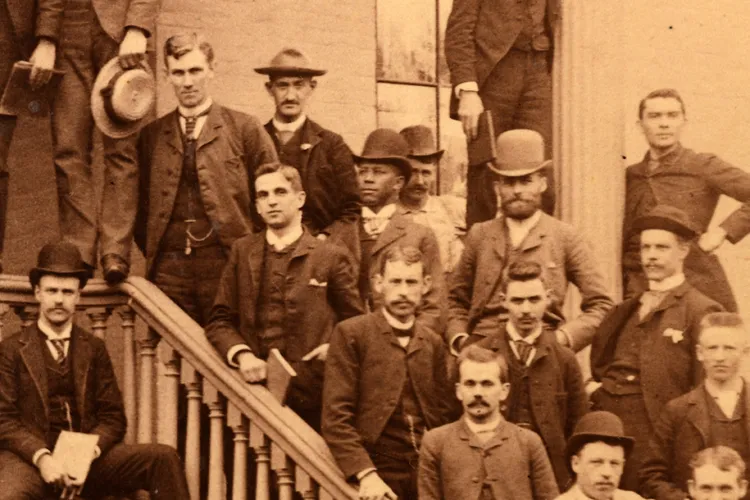
Cornelius McKane, M.D., was the third African American student to graduate from the UVM College of Medicine. A detailed view of the class of 1891 shows Dr. McKane standing in the middle of the upper step of the staircase.
New Homes, New Problems
By the 1880s, the college had outgrown Pomeroy Hall, the brick building, still standing south of the UVM Green, that had been its home since 1829. Local philanthropist John Purple Howard refurbished and donated a mansion at the corner of Prospect and Pearl Streets to be the new home of the college, complete with its first semi-circular lecture hall. It was in that hall that an errant cigar butt, dropped into the space under the seats, sparked a fire that consumed the building on the morning of December 3, 1903. The university swiftly rebuilt on the site. By the summer of 1905 the third “permanent home” of the college was completed—the building, now known as Dewey Hall, that still stands north of the Green.
The fire was not the last of the school’s troubles. In 1910, the Carnegie Foundation for the Advancement of Teaching, as part of an effort to reform medical education, appointed Dr. Abraham Flexner to examine all North American medical schools and suggest improvements. Flexner’s report was a body blow to UVM. He concluded that New England needed only two medical schools and recommended closing all but Harvard’s and Yale’s. (His report also led, tragically, to the closure of many of the nation’s historically black medical schools.) Dean Henry Tinkham had no intention of closing UVM’s medical school but did act on many of Flexner’s recommendations, revamping the curriculum and hiring new permanent faculty. It was not the last crisis the college would face. By the 1930s, faculty numbers had again slipped, and the American Medical Association threatened to revoke the school’s accreditation. A faculty committee led by radiologist A. Bradley Soule, M.D.’28 led an effort to again reorganize, and the crisis was averted.
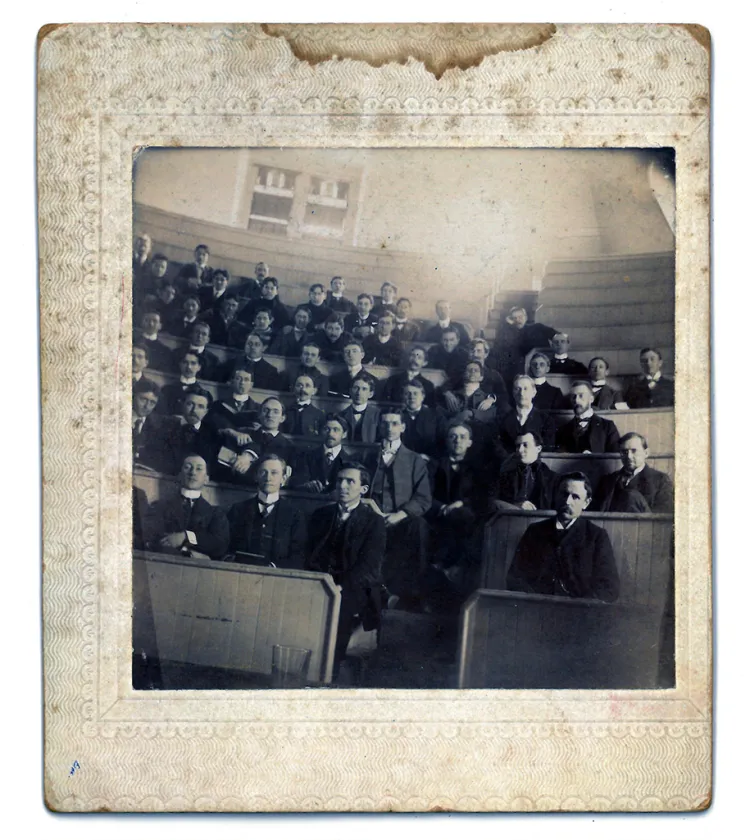
Part of the UVM medical student body gathered in March of 1900 for this photograph in the amphitheater of the COllege of Medicine building at Pearl and Prospect Streets. Less than three years later, a fire that started in this room would comsume the entire structure.
The Modern Med School
By the late 1950s it was clear that, to remain a viable medical school, the college would have to grow both its student body and its research enterprise. After an extensive fundraising drive involving hundreds of alumni, and a major grant from the Irene Heinz Given and John LaPorte Given Foundation, the college’s new home was completed in 1968, with new lecture halls and extensive laboratories in its 235,000 square feet of space. It was named in honor of the Givens.
Over the years, in the laboratories of Given, and more advanced facilities added in early in this century, researchers would bring forth new knowledge in many areas. Now, each year more than $100 million of grant-supported biomedical research takes place in laboratory, clinical, and community settings, work that brings greater understanding of disease and wellness, and new, more effective treatments for cancer, and in the areas of cardiovascular, immunobiology and infectious disease, metabolic, neuroscience, and pulmonary and environmental disease, as well as health services research and education, outcomes research, and quality improvement. This fall, scientists moved into the latest addition to the medical campus, the 62,500-square-foot Firestone Medical Research Building, named for the family of its lead donor, Steve Firestone, M.D.’69.
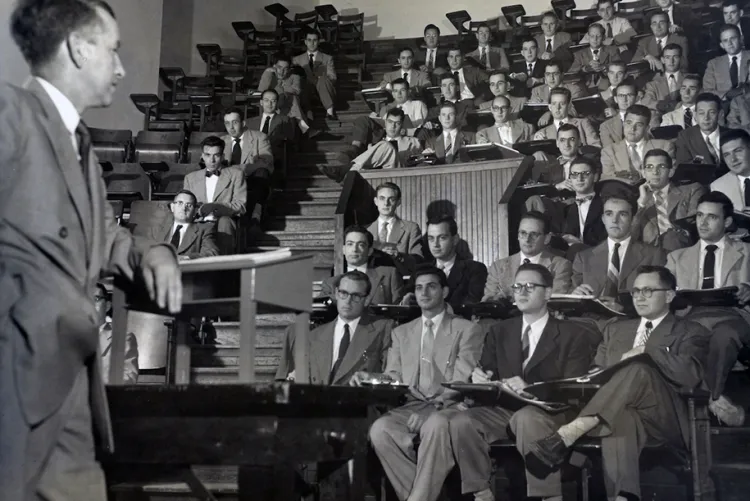
Chair of Medicine Ellsworth Amidon, M.D. '32 speaks to the medical students of the Class of 1955 in Hall A, the main lecture hall of the College from 1905 to 1968. Amidon led UVM's Department of Medicine from 1942 to 1964.
Growth and Change
Along with an increase of the “footprint” of the college came growth of and change in the student body. Today, there are about 124 medical students in each class. At the same time, the number of graduate students working in biomedical labs has grown to more than 300.
The diversity of students had a much slower and intermittent record of growth. It took a century for the first female medical students to be admitted—to the Class of 1924. And for more than 50 years after that, women were only rarely granted admission. Only in the 1970s and 80s did this begin to change, to the point where about 60% of the most recent medical classes identify as female.
For students of color, the path to a UVM M.D. was even more difficult. The college first enrolled an African American medical student, Thomas James Davis, in the Class of 1885. He was followed by just 11 others over the next three decades. Today, this situation is changing, with 23% of the current Class of 2026 coming from backgrounds considered underrepresented in medicine. And in the last two decades, American society’s gradual acceptance of varied sexuality and gender preferences has been mirrored in the college’s student body, where 19% of the most recent class identifies as LGBTQA+. Under current Dean Richard L. Page, M.D., the college has emphasized adherence to its “Statement of Professionalism” that stresses “cultural humility, kindness, and respect” as guiding principles for all members of the Larner community.
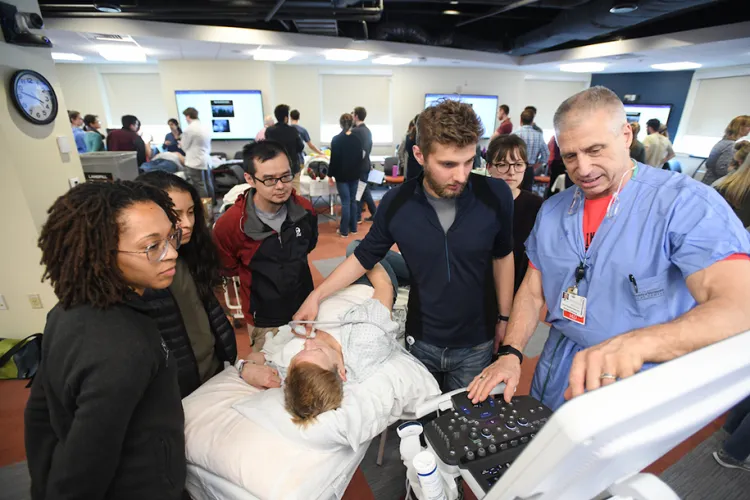
Class of 2022 medical students are instructed in the use of point-of-care ultrasound in an active learning setting in the College's Medical Education Center. Almost all of today's medical cirriculum involves active learning instead of lectures.
The Namesake
In 2016, the largest lifetime giving by any UVM graduate resulted in the college’s current name. Raised in the Old North End of Burlington in a family of very modest means, Robert Larner, UVM’39, M.D.’42 settled in Los Angeles after his service in World War II and built a thriving internal medicine practice while also making carefully researched and managed investments in California real estate with his wife and business partner, Helen. The Larners were longtime donors to his medical alma mater, and in 2016 they capped decades of “giving back” with a transformative gift that provided a total of $100 million to support medical education. In September 2016 the college was renamed in recognition of Dr. Larner, becoming the first medical school in the nation named for an alumnus.
Dr. Larner stated that he had one major goal with his philanthropy: “I wanted to help other medical students have the kind of stimulating, gratifying practice of medicine that I’d had,” he said.
The Larners’ support allowed the college to expand its restructuring of the medical curriculum to emphasize active learning modes in place of static lectures. Those changes, and the educational technology developed to support them, also allowed the college to quickly pivot to online learning in the early days of the COVID-19 pandemic. Today, well over 90% of a medical student’s time is spent engaged in hands-on learning, in special classroom facilities on campus, at clinical sites throughout the UVM Health Network, and at the college’s clinical branch campus in Danbury and Norwalk, Conn., which was established in recent years in partnership with Nuvance Health. Two centuries after four graduates were granted their medical degrees in 1823, more than 120 new UVM physicians each year go on to serve that most important person, the patient, at more than 60 institutions across the nation, including, of course, those in Vermont, where today about a third of practicing doctors began their careers of service at the academic medical center at UVM.
